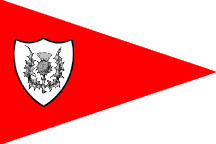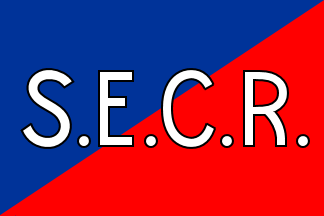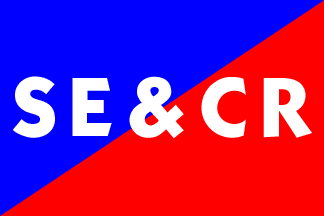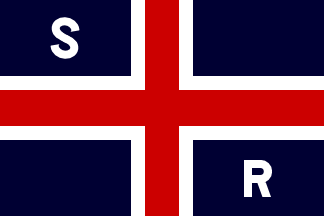![[Midland Railway flag]](../images/g/gb$mlrw.gif) image by António Martins-Tuválkin, 19 February 2007
image by António Martins-Tuválkin, 19 February 2007
Last modified: 2024-09-21 by rob raeside
Keywords: railway |
Links: FOTW homepage |
search |
disclaimer and copyright |
write us |
mirrors
See also:
![[Midland Railway flag]](../images/g/gb$mlrw.gif) image by António Martins-Tuválkin, 19 February 2007
image by António Martins-Tuválkin, 19 February 2007
Post card collection shows a white
swallowtail flag with the crest of the company coat of arms on it (http://www.midlandrailwaystudycentre.org.uk/MirrorCrest.gif).
This is a green wyvern with red and white striped belly and red spinal horns and
wings.
António Martins-Tuválkin, 10 January 2008
See also:
![[London and North Eastern Railway flag]](../images/g/gb$lner.gif) image by António Martins-Tuválkin, 21 February 2007
image by António Martins-Tuválkin, 21 February 2007
Post card collection shows a blue flag
with a white saltire charged over all with a white red-edged lenticular
shape charged with red sans-serif capitals spelling "LNER", the two middle
letters being larger.
António Martins-Tuválkin, 21 February 2007
The saltire would seem to be a reference to the fact that the LNER operated
the East Coast Main Line link between London and Edinburgh, including the famous
Flying Scotsman service. The LNER was formed in 1923 as a result of the 1921
Railways Act grouping the railways. It served the east of Scotland and England
north of London, and existed until nationalisation in 1948.
Jonathan Dixon, 21 February 2007
1923-33 flags were also in this pattern but the LNER logo is shown in the
post card collection in a pillbox shape (the
outline of two discs connected by parallel tangents). Additionally these three
flags had a specific symbol on the hoist side triangle area of the background.
None of these is shown on the LNER coat of arms:
http://www.crphillips-models.co.uk
![[London and North Eastern Railway flag]](../images/g/gb$lnerc.gif) image by António Martins-Tuválkin, 8 August 2007
image by António Martins-Tuválkin, 8 August 2007
London & North Eastern Rly. (1923-33 for former Gr. Central Rly.
Ships). As described, with white red fimbriated upright five-pointed star.
António Martins-Tuválkin, 8 August 2007
![[London and North Eastern Railway flag]](../images/g/gb$lnere.gif) image by António Martins-Tuválkin, 8 August 2007
image by António Martins-Tuválkin, 8 August 2007
London & North Eastern Rly. (1923-33 for former Gr. Eastern Rly.
Ships). As described, with red wing crest on torse. This seems to be the
London city crest, but the wing is depicted as plain red, not patterned
after a St. George Cross.
António Martins-Tuválkin, 8 August 2007
![[London and North Eastern Railway flag]](../images/g/gb$lnern.gif) image by António Martins-Tuválkin, 9 August 2007
image by António Martins-Tuválkin, 9 August 2007
London & North Eastern Rly. (1923-33 for former North British Rly. Steamers. As described, with white ogival shield charged with a thistle
proper (the image is too small to be sure, though).
António Martins-Tuválkin, 9 August 2007
The common house flag with an identifying emblem in the hoist was introduced
17 February 1932 as an economy measure. The original house flags, introduced 24
April 1923 were:
Harwich. St Andrew's flag with a red dragon's left wing on
a central white circle.
Grimsby. A white star on a red pennant.
Scottish
Services. Thistle on a white shield on a red pennant.
[National Archives
(PRO) RAIL 390/305]
David Prothero, 7 January 2009
 image by António Martins-Tuválkin,
6 May 2010
image by António Martins-Tuválkin,
6 May 2010
From a postcard collection: 10.3.1: North
British Railway
Postcard #10, 3rd row, 1st flag of the
collection reads "North British Railway" and
shows a red pennant with a black thistle on a white, black edged, ogival shield.
António Martins-Tuválkin,
6 May 2010
The first meeting of the promoters of a scheme to build a 57 mile railway
linking Edinburgh with Berwick took place on 8th January 1842. Two years later,
having secured the necessary finance, the North British Railway Company was
incorporated and, on 4th July 1844, obtained an Act of Parliament authorising
the construction of the line. Work began soon afterwards and the line was opened
on 18th June 1846. The NBR was physically linked to the York, Newcastle &
Berwick Railway on 29th August 1850, when the Royal Border Bridge at Berwick was
opened. The NBR then became the Scottish part of the continuous east coast
railway route from London to Edinburgh.
Headquartered in Edinburgh,
Scotland’s capital city, the Company expanded rapidly after the 1846 opening
and, following a series of amalgamations and take-overs, it became the largest
of the Scottish railways by the mid-1860s. By that time, it had opened a number
of branch lines, built a new main line from Edinburgh to Carlisle, taken over
the Edinburgh, Perth & Dundee and Edinburgh & Glasgow railway Companies, and
absorbed numerous smaller railway operations. In the 1880s, it built the current
Tay Bridge and the massive Forth Bridge (in a joint venture with its partner
railway companies) and, by the end of the 19th century, it had built the West
Highland Railway from Glasgow to Fort William. In fact, by the beginning of the
20th century, the Company’s rail services stretched from Newcastle to Aberdeen
on the east and from Silloth in Cumbria to Fort William and Mallaig in the west.
At the Grouping of UK railways in 1923, the NBR became a major constituent of
the London & North Eastern Railway which, in turn, became part of the
nationalised British Railways in 1948. In the 1960s many of the smaller ex-NBR
branch lines were closed, together with the main line between Edinburgh and
Carlisle (the Waverley Route). Britain’s railways were returned to the private
sector in 1994, and today’s ex-NBR passenger railway system in Scotland is
operated by First ScotRail, together with other Companies providing cross-border
passenger and freight services.
North British Railway Study Group
http://www.nbrstudygroup.co.uk/page6.html
Ivan Sache, 3 May
2021
See also:
 image by Eugene Ipavec, 18 August 2009
image by Eugene Ipavec, 18 August 2009
A British railway firm operating ships was the South Eastern Railway Co.
founded in 1844. As described by The Ships
List:
“In 1854 the South Eastern Railway Company took over the fleet
of the South Eastern & Continental SP Company and ran Folkestone /
Dover-Boulogne / Ostend services. In 1899 the company merged its fleet with the
London, Chatham & Dover Railway to form the South Eastern & Chatham Railway
Company joint fleet. (...) They ran services between Folkestone / Dover -
Calais / Boulogne. In 1923 they became part of Southern Railway.”
Griffin’s ‘Flags National and Mercantile’ (1891), from the third edition of
Griffin (1885), shows the house flag under no.
515: ‘S. Eastern Railway Co. London’. It is a dark blue field, white
initials “S.E.R” (two dots only; no serifs). The ‘Scran’ site shows a modern
rendition with three dots:
http://www.scran.ac.uk/database/record.php?usi=000-000-550-930-C. Additional
information:
http://en.wikipedia.org/wiki/South_Eastern_Railway_(UK) and
http://www.simplonpc.co.uk/SR_SECR1.html.
Jan Mertens, 17 August 2009
 image by António Martins-Tuválkin, 10 May 2010
image by António Martins-Tuválkin, 10 May 2010
Variant flag shown on a postcard collection: 11.2.14 South
Eastern Railway.
Postcard #11, 2nd row, 4th flag of the
collection reads "South Eastern Railway",
early funnels black, and shows a dark blue flag with "SER" centered on it, set
in white bold san-serif capitals [without periods].
António Martins-Tuválkin, 10 May 2010
 image by Neale Rosanoski, 4 December 2010
image by Neale Rosanoski, 4 December 2010
According to
Lloyds (1912) and the Liverpool Chamber of Commerce 1885 sheet the
letters, without dots, were in the base of the flag and above them was a
vertical white anchor. The version without the
anchor is shown by
Griffin (1883) [no edition number given] which shows dots after
each letter in line with the Scran site and also it is so described in Merchant
Fleets No. 24 where the author states that the flag was "blue with the white
letters S.E.R." although it is then displayed on the on the back cover without
dots in line with the image by António.
Neale Rosanoski, 4 December
2010
 image by Eugene Ipavec, 19 August 2009
image by Eugene Ipavec, 19 August 2009
The on-line 1912 Lloyds Flags & Funnels
shows the house flag as no. 1793 on original page 122
- Divided per ascending diagonal, blue (hoist) and red (fly), white company
initials “S.E.C.R.” over all; these letters are rather thin and have no serifs.
The complete caption found in this
1912 source: ‘South Eastern & Chatham Railway, Royal Mail Service,
London’.
Jan Mertens, 18 August 2009
 image by António Martins-Tuválkin, 13 May 2010
image by António Martins-Tuválkin, 13 May 2010
Variant flag shown on a postcard collection:
12.1.1 South
Eastern and Chatham Railway.
Postcard #11, 1st row, 1st flag of the
collection reads "South Eastern and
Chatham Railway", and shows a ~2:3 diagonally divided flag, blue on the upper
hoist and red on the lower fly reading "SE&CR" in one centered line overall set
in white bold sans serif capitals. See
http://en.wikipedia.org/wiki/South_Eastern_and_Chatham_Railway &
http://en.wikipedia.org/wiki/South_Eastern_and_Chatham_Railway#Ships about
the company and its ships (I have no idea if the flag was used also ashore).
António Martins-Tuválkin,
13 May 2010
 image
by Eugene Ipavec, 17 August 2009
image
by Eugene Ipavec, 17 August 2009
From
http://www.plimsoll.org/OnTheLine/ShippingLines/southernrailwaycompany/default.asp#2:
The London & South Western Railway, active since 1840, starts shipping in 1843
as the 'New South Western Steam Navigation Company'. Other railway firms start
cross-Channel and coastal shipping lines; various mergers occur. Finally, in
1923, "the London & South Western, London Brighton & South Coast and South
Eastern & Chatham Railway Companies merge to form the Southern Railway. The new
company operates trains and ships across the south east of England". When after
WWII the British Transport Commission assumes control of the railways, the
shipping activities follow (1948). The situation does not change on the
formation of British Rail, however its shipping activities come to an end when
Stena and Sealink UK acquire them (1979).
The Southern Railway house flag was blue with a red cross throughout, fimbriated
white, and white letters 'S' (upper hoist) and 'R' (lower fly).
Jan Mertens, 15 April 2005
An image of a Southern Railway flag is seen at
http://www.bluebell-railway-museum.co.uk/images/a007.JPG.
Jan Mertens,
16 August 2009
A postcard collection: 12.1.2 Southern Railway.
Postcard #11,
1st row, 2nd flag of the
collection reads "Southern Railway", and shows
essentially the same flag as above, but in the brighter shades of both red and
dark blue of this source; the red cross is thicker and its white fimbriation
thinner, as well as the letters.
António Martins-Tuválkin, 13 May 2010